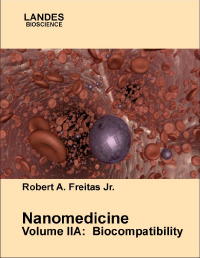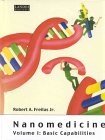Home > News > Old Company Press Releases > Nanomedicine News
Nanomedicine Vol. IIA: Biocompatibility - by Robert A. Freitas Jr.
|
October 17th, 2003
The second volume in the Nanomedicine book series by Robert A. Freitas Jr., Nanomedicine, Vol. IIA: Biocompatibility, has been published by Landes Bioscience. This comprehensive technical book describes the many possible responses of the human body to the in vivo introduction of future medical nanorobots. Such advanced nanodevices could quickly eliminate pathogens and cancer cells, conduct molecular repairs of damaged biological structures, and restore and maintain the body in a state of youthful health, revolutionizing 21st century medicine. It is likely that the first medical nanorobots may be buildable 10-20 years from today using an advanced molecular manufacturing technology. |

© Robert A. Freitas Jr. Nanomedicine, Volume IIA: Biocompatibility, Landes Bioscience, Georgetown, TX, 2003 |
 © Robert A. Freitas Jr. Nanomedicine: Basic Capabilities, Vol. 1 Landes Bioscience, Georgetown, TX, 1999 Reviews |
The first volume in the Nanomedicine book series, Nanomedicine, Vol. I: Basic Capabilities, was published by Landes Bioscience in 1999. Volume I described manufacturing pathways for medical nanorobots and the many technical capabilities these nanodevices must have in order to perform their medical missions including onboard sensors, molecular pumps and valves, computers, energy supplies and power transmissions, and components for communication, navigation, manipulation and locomotion. |
Volume IIA extends this analysis by considering whether medical nanorobots will be biologically compatible with the human body. The safety, effectiveness, and utility of medical nanorobotic devices will critically depend upon their biocompatibility with human organs, tissues, cells, and biochemical systems. While classical biocompatibility has often focused on the immunological and thrombogenic reactions of the body to foreign substances placed within it, Nanomedicine Vol. IIA broadens the definition of nanomedical biocompatibility to include all of the mechanical, physiological, immunological, cytological, and biochemical responses of the human body to the introduction of medical nanodevices, whether “particulate” or “bulk” in form.
Since a common building material for medical nanorobots is likely to be diamond or diamondoid substances, the first and most obvious question is whether diamondoid devices or their components are likely to be hazardous to the human body. Chapter 15.1 briefly explores the potential for crude mechanical damage to human tissues caused by the ingestion or inhalation of diamond or related particles.
Classical biocompatibility refers to the assessment of the totality of nanorobot surface material-tissue/fluid interactions, both local and systemic. These interactions may include cellular adhesion, local biological effects, systemic and remote effects, and the effects of the host on the implant. Chapter 15.2 summarizes the current status of medical implant biocompatibility and then discusses the important future nanomedical issues of protein interactions with nanorobot surfaces, immunoreactivity, inflammation, coagulation and thrombosis, allergic reactions and shock, fever, mutagenicity and carcinogenicity.
A great deal of preliminary information is already available on the biocompatibility of various materials that are likely to find extensive use in medical nanorobots. Chapter 15.3 includes a review of the experimental literature describing the known overall biocompatibility of diamond, carbon fullerenes and nanotubes, nondiamondoid carbon, fluorinated carbon (e.g., Teflon), sapphire and alumina, and a few other possible nanomedical materials such as DNA and dendrimers in both bulk and particulate forms. The purposeful movement of solid bodies and particulate matter through the various systems of the human body is also of particular interest in nanomedicine. Chapter 15.4 examines the requirements for intact motile nanorobots that can locomote inside the human body while avoiding geometrical trapping, phagocytosis, and granulomatization, thus achieving controlled or indefinite persistence without clearance by the natural immune system. The analysis extends to the fate of free-floating nanorobots and their material ejecta, or fragments, as well as the fate of motile nanorobots that have malfunctioned and lost their mobility, or which are moving passively through the body, or are being driven by cell-mediated processes.
Chapter 15.5 describes the mechanical interactions of nanorobotic systems with human skin and other epithelial tissues, including mechanical tissue penetration and perforation leakage, as well as mechanical interactions with vascular systems, extracellular matrix and tissue cells, and nontissue cells such as erythrocytes, platelets, and leukocytes. The Chapter ends with a detailed review of cytomembrane and intracellular mechanocompatibility, and a brief consideration of electrocompatibility and nanorobot-nanorobot mechanocompatibility.
Finally, otherwise biocompatible medical nanodevices might provoke unwanted reactions by simple physical displacement of critical biological systems or fluids. Chapter 15.6 examines issues of volumetric intrusiveness the degree to which artificial systems can safely displace natural systems volumetrically. The brief discussion includes a look at the acceptable limits of volumetric intrusiveness of macroscopic objects placed inside the human body (or its various organs), the bloodstream, and in individual human cells.
The primary intended audience of this book is biomedical engineers, biocompatibility engineers, medical systems engineers, research physiologists, clinical laboratory analysts, and other technical and professional people who are seriously interested in the future of medical technology.
The full Table of Contents for the book Nanomedicine, Vol. IIA (2003), is
available online here. The book is
currently available for purchase at $99 in hardcover from Amazon.com
here, and includes 348 pages,
6259 literature references, and an extensive index. Interested parties may
contact the author by email at rfreitas@rfreitas.com or visit his homepage.
The full text of the first volume in the series, Nanomedicine, Vol. I
(1999), is available online here, and the
book may also be purchased at $89 in softcover from Amazon.com
here, from Barnes &
Noble
here,
or from many other web sources.
Contact:
Robert A. Freitas Jr.
rfreitas@rfreitas.com
Reprinted with premission.
Copyright Robert A. Freitas Jr.
If you have a comment, please
us.
|
|
||
|
|
||
| The latest news from around the world, FREE | ||
|
|
||
|
|
||
| Premium Products | ||
|
|
||
|
Only the news you want to read!
Learn More |
||
|
|
||
|
Full-service, expert consulting
Learn More |
||
|
|
||